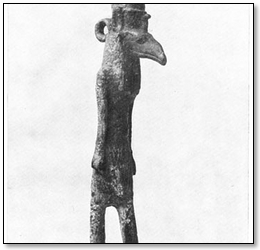ORGANIZATION OF ANCIENT EGYPT

Phtah, the Egyptian god of Memphis
Egypt was divided into Upper and Lower Egypt from prehistoric times. The usual royal title of the ruling Pharaoh was "king of the two lands". This title and reference to the Egypt being two lands points to an original independence, whose termination tradition ascribes to Menes, the first king. Upper Egypt always had precedence and was mentioned first in the royal nomenclature. It was known as Ta-res, or with the article Pa-ta-res, "the south land," the PATHROS (q. v.) of the Hebrews.
The Delta was Ta-meh, "north land," the Mazor of the Hebrews. For administrative reasons the Ptolemies and Romans made a third district, Middle Egypt, but this was a political invention. In practice there were always two Egypts: the Upper (Southern) Egypt and the Lower (Northern) Egypt. The reference to the southern part of Egypt as being the Upper Land probably points to the Egyptian's view of looking at the world and geography. Since the life giving Nile came from the south, and flowed downward to the Delta, the country closest to the source was seen as above the lands farther down river.

Egyptian artefact
In addition to the two broad divisions of Upper and Lower Egypt, there were many smaller administrative divisions. In the geographical lists from the times of Thothmes III. (eighteenth dynasty) and his successors, smaller divisions are noted, twenty-two in Upper and twenty in Lower Egypt (the numbers are not always the same). These districts, called nomoi by the Greeks, had each its own particular deity or deities, worship, festivals, and sacred animals.
Although Diodorus (i., 54) ascribes the nomos-division to Sesoosis (Sesostris, q. v.; Ramses II., nineteenth dynasty), that of Upper Egypt is supposed to have antedated the establishment of the kingdom, and that of Lower Egypt to have been arranged merely by way of imitation. The particular names of these subdivisions had reference to the deity worshiped, the chief city, local characteristics, or geographical position; Greek designations were based on the first two grounds. Complete lists are to be found in any good history of the land. Boundaries.—The natural southern boundary of Egypt was near Assouan at the first cataract of the Nile, though under Usertasen III. (twelfth dynasty) it was pushed forward to Semneh, just beyond the second cataract (in order to gain control of the mines of Nubia), and later still under Thothmes I. the conquest was continued to the third cataract, and by Thothmes III. to the Sudan. At Syene was a place of barter with the Nubians and the peoples of the south, and from one of the principal articles (ivory) of this trade the island of Abu, Elephantine, got its name.

The hieroglyphic symbol for Egypt
At Senaneh a stele was erected by Usertasen III. forbidding the northward passage of foreigners in other than Egyptian boats. At Abu-Simbel (see IP-SAMBUL) Ramses II. executed two wonderful rock-hewn temples.
Across the isthmus of Suez, marking the northeastern frontier, there extended during a part of Egyptian history a line of fortifications protecting all avenues of approach, to which the name "wall of the prince" was applied. It was by no means a continuous structure. An unpublished papyrus at St. Petersburg ascribes its construction to Snofru of the fourth dynasty (see below), and a papyrus of the twelfth dynasty, at Berlin, recounts the difficulty which a fugitive Egyptian had in passing the sentries set to watch against marauders.
______________________________________________________________________________ * "Ancient " Egypt here designates the entire period which closed with the Ptolemies in 30 B. c., including the Old Kingdom (Dynasties I.-VI.), the Middle Kingdom (XII.-XIII.), the New Kingdom (XVIII.- XX.), the Tanite, Bubastite, and Saite dynasties (XXI.-XXIV.), the Ethiopian domination (XXV.), the second Saite (XXVI.), the Persian (XXVII.), contemporary in part with the third Saite, the Mendesian and Sebennyte (XXVIII.-XXX.), and finally the Ptolemaic period, 324-30 B. c.pyramids Egypt Mummies Search Engines Link Report
Egyptian Cities | Egyptian Education | Ancient Egypt | egyptian clothing | Egyptian Houses | The Egyptians | Egyptian Family Life | Egypt and its Neighbours | Government in Ancient Egypt | Egyptian History | Military | Organization of Ancient Egypt | Recreation | Egyptian Religion | Pyramids | About | Privacy Policy | Site News | Site Map
EgyptPast.com - Facts and Information About the History of Ancient Egypt
-